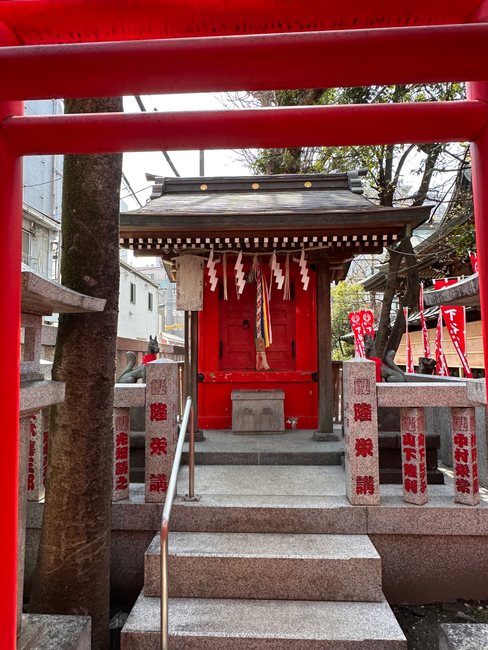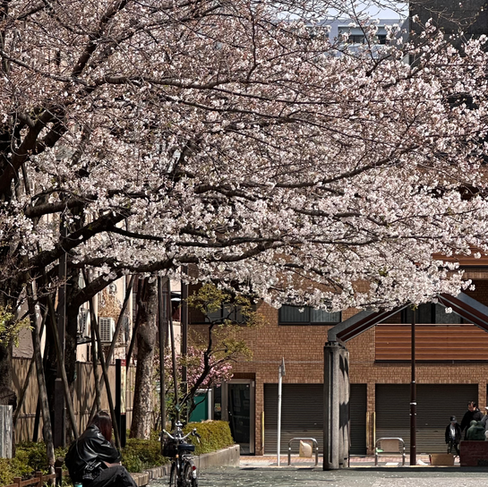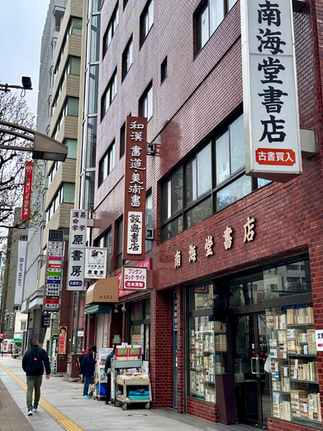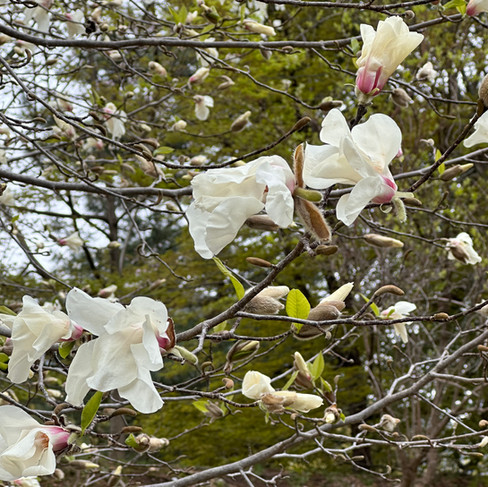Our Asian Adventure: Tokyo, Part 2 - Hanami, goshuin and finally, some taiyaki (and one last bowl of ramen)
- debbiemanderson1
- 5 days ago
- 14 min read
Updated: 11 hours ago

After spending a delightful day with a private guide seeing some of the lesser-known sights in Tokyo, it was time to check out some of the 'must-sees', but we found some quiet spots in the process.
If you happen upon Tokyo in late March or April, those cherry blossoms are an attraction. As I said in my blog, "Tokyo, Part 1 - sometimes the best sights are off the beaten path, especially with a local tour guide (and you might even find some vintage vinyl)", millions of people flock to Japan and millions of Japanese travel within the country in March and April to view the phenomenon that is cherry blossom season. As I also explained, most of the cherry trees in Japan are 'cloned' or grafted which produces rows of trees that are identical in height and size due to sharing the same DNA. This allows for massive rows of colour - and massive photo ops.
There are several key areas to grab the 'best' view of the cherry blossoms in Tokyo. We chose to ride the Keisei line train from Narita Airport (we were staying at the Tobu Airport Hotel) to the Ueno Station, just steps from the magnificent Ueno Park, one of the prime cherry blossom viewing sites. In fact, it's called the "hot spot" for cherry blossoms by the Japanese National Tourism Organization and is one of the most popular parks in Tokyo. It is estimated that there are over 1,000 trees in the park, so you can imagine that the sky is a bank of pink blossoms. Ueno Park opened in 1873. It's official name is Ueno Onshi-Koen or "The Ueno Imperial Gift Park".

One thing we did not know, however, is that Ueno Park is the home for the annual Ueno Cherry Blossom Festival in late March and early April. Besides the bountiful and beautiful blossoms, we were quite taken by the thousands of people sitting close together on the grass, talking, visiting, and picnicking. I learned later that they were practicing 'hanami' when people get together and literally sit under cherry blossoms to visit and eat. Despite the crowds, the atmosphere was happy and calm. The peaceful party continues into the evening as the trees are lit at night by street lamps which must be an incredible sight. We were impressed with the garbage/compost collection bins and the signs stating that "The Party Ends at 8:00 pm". I imagine that there was not one scrap of garbage left - the Japanese are really that tidy. Hanami is quite a beautiful practice. A good article is "What is Hanami? The Fun Way Japanese Enjoy Sakura Viewing" by Live Japan Perfect Guide at livejapan.com.

You can walk the length of Ueno park down 'Main Street' which is lined with, you guessed it, cherry trees and from this 'street' you can access the Ueno Zoo, the Tokyo National Museum, the Tokyo Metropolitan Art Museum, the National Museum of Western Art, the National Museum of Nature and Science, the Kaneiji Temple, and the Shinobazu Pond. The Main Street is crowded but calm. There is so much to do in this park, another visit (or two or three) is warranted.
'Main Street' at Ueno Park:

Here's just a couple of the museums. The National Museum of Western Art:

The National Museum of Nature and Science:

A life size statue of a blue whale, the world's largest animal, diving below the ocean surface sits outside the Nature and Science Museum.

There's a lot to see at Ueno Park. Besides the museums and nature, it is a spot for food stalls and fun. We spotted this Elvis impersonator competition.

And here's a statue of Saigo Takamori, considered by some as "the last true samurai". Samurai (and Saigo Takamori) have a lengthy history in Japan that you might want to research . He was a fighter and a poet who it is believed was the model for an important character in the movie 'The Last Samurai'. Here, he's with his loyal dog, Hachiko.

Although the Ueno Train Station and Ueno Park might be elbow-to-elbow, the side streets are much quieter, especially on the Sunday morning when we visited. We wandered the neighbourhood for a couple of hours, simply enjoying strolling and seeing what we could see - from little store fronts (closed) to, of course, a hidden shrine.
The Shitaya Shrine is one of Tokyto's oldest Inari Shrines. The current main hall dates to 1934. It was known to be the first setting for vaudeville in Tokyo, a five day performance. We wondered why people were lined up at a little office window. I now know they were collecting 'goshuin' which is a temple seal that commemorates your visit. The Shitaya seal is a panda which changes shape monthly. We did not get one, but collecting goshuins would be a great travel activity, especially if you are travelling with the kids. There is a delightful hand washing station and a sub-shrine, Ryuei Inari Shrine, with red Torii gates in the same complex.
This is a goshuin from Shitaya Shrine. This picture is credited to a very thorough, and recommended, blog about the shrine, 'Shitaya Shrine Introduction to It's Cute Panda Goshuin, Benefits, and History' at rekishinokura.com

Some neighbourhood snaps:
It was in this neighbourhood that we sampled the piece-de-resistance, canned coffee from a vending machine (not because it was great but because I cannot resist anything 'coffee') - and then we started noticing the preponderance of coffee vending machines in Tokyo, several on a block. There are about three million vending machines in Japan (they have statistics for everything). Vending machines in Japan date back to 1888 and provide convenience and affordable products - and access to food and drink and many other items such as cake in a can or instant ramen without having to interact with other people. I imagine this is important when the population density in Tokyo is about 6,150 per square kilometre, and you just need a break from people. (In comparison, the population density of Canada's largest city, Toronto, is about 4,150 per square kilometre.) An interesting article about the history and importance of vending machines in Japan is 'Guide To The Fascinating Realm Of Japanese Vending Machines' by Ryoma Takano at japancrate. com. (I'm glad I'm not the only one fascinated.) Suffice it to say, whatever you need, there's probably a vending machine for that.
Remember that amazing Hainanese coffee I talked about in my Singapore blog posts? Well, Tokyo's coffee in a can isn't even close - it tasted alright but was lukewarm, and I suspect that residents drink it only for the convenience and caffeine buzz. I found this far more amusing than it is.
The streets closer to the Ueno Station and Ueno Park were busier, lined with shops and restaurants and the crowds that were probably going to spend the afternoon in Ueno Park.

We found a small cafe, Shinobu Ueno Ten, filled with locals, where we shared some dishes. It was delicious.
One of the things they say to do when you visit Tokyo is visit the Shibuya Scramble Crossing. The Shibuya ward butts up to Shinjuku in downtown to form the 'heart' of Tokyo. It's probably the busiest part of the city. Up to 1,000 people cross the Scramble Crossing at any one time. It was a rainy day, so maybe the numbers were lesser when we were there, but the umbrellas made for interesting photos. Everyone knows that to get the best shot, sneak onto the second floor of Starbucks across the street from the station which is exactly what we did.
And . . . . .GO!


Shibuya is lined with shopping, entertaiment, restaurants - and people. It's a centre for fashion, neon lights, and flashing video screens.

Shiibuya is also home to vinyl record stores. My partner was not disappointed. In fact, he was ecstatic to find that Tokyo is a haven for vinyl with many stores with affordable prices. (Japan is known for the quality of the 'pressings' of vinyl records.) The only thing that stopped him was a lack of suitcase space. He checked out two stores - the smaller Disk Union (which some believe to be the best used-vinyl store in Tokyo) and the massive Tower Records, one of the biggest Tower Record stores in the world with nine floors of albums and CD's and memorabilia. Both resulted in some real 'finds', almost enough to fill up his ever-present canvas tote bag which holds exactly 21 albums.

Despite the crowds and upscale shopping, Shibuya is not short of affordable, quality eating establishments. We found a delightful little shoulder-to-shoulder ramen shop, Ajigen Kumamatsuri Okumura, tucked away upstairs - perfect for a wet, cold, windy day.
Another place that is on the recommended-to-visit list is the Imperial Palace Grounds. But first we found another off-the-beaten-path neighbourhood and had a delightful morning - and then realized that the Imperial Palace Grounds were only steps away.
One of my traveling companions (the vinyl records one, of course) discovered that the Jinbocho neighbourhood is home to shop after shop of booksellers. So, off we went. Jinbocho has an interesting history. It is known as Jinbocho Book Town due to the many used book stores and publishing houses. The Book Binding Club and Literature Preservation Society are also found here, as well as a number of notable universities. (It was probably the development of universities in the late 19th century in the area that gave rise to the bookstores.) So, Jinbocho is an area full of university students, books, and small cafes - one of my favourite big-city atmospheres. It was so enjoyable to watch the book sellers opening for the day. Although the books were all in Japanese, you can't beat the smell of bookstores; and the rows of used books make for a wonderful collage of pictures.
First of all, the Jinbocho train station, covered completely with bricks that resemble a library. Brilliant. I love train station decor, but that's another topic altogether.
One thing I have learned from traveling is that you can find interesting places that will never make the tour guides because they are not big and flashy - just interesting . One such place is the Takeo Paper Shop founded in 1899. Jinbocho, with all it's book stores, is a fitting location for a paper store. The Paper Shop mostly sells paper for business cards and notebooks. I loved the array of colours.
Upstairs is a small exhibit about, well, paper and printing and design.
We had read that there is a popular cafe in Jinbocho called Glitch Coffee and Roasters so we naturally had to hunt it down. This is not an ordinary coffee shop. It is for "coffee connoisseurs". First of all, there was a lineup that snaked out the door and onto the sidewalk. Second, when you do finally get inside, you pick your drink but then the barista will help you select the right bean for your drink. Thirdly, the drink is then purposefully custom made, and it is an art to watch. It's a lengthy process. Some of the prices reach about $35.00 Canadian per cup. Yes, per cup. (But you also receive a card telling about your cup of coffee such as the origin, aroma, sweetness, etc , if that helps any with that price.) By the way, Glitch swears by light roast coffee, never dark roast. So, did we pay up to $35.00 for a cup of coffee? No, no we did not. But aficionados say the price is worth it; and an online search reveals that Glitch is truly a labour of love by the founder who believes in promoting pure coffee. It just depends what you want from a cup. We did grab a good picture of one of my travelling buddies in a sweet little nook outside the cafe when he discovered the price.

So, down the street we went and found Dill Coffee Parlor which was a lovely ordinary coffee house with very good coffee and a perfect scone which is just what we were looking for.
The Imperial Palace Grounds (the former site of the Edo Castle which was occupied between 1603 and 1888) are just a short walk from Jinbocho and are situated in pretty much the centre of Tokyo. The palace of the Emperor of Japan sits in a large sectioned-off part that is generally not open to the public. The Emperor of Japan is Emperor Naruhito who is considered a 'hereditary monarch' meaning his position is passed down through the family line. Japan's monarchy is one of the oldest ongoing monarchies in the world. Interestingly in this day and age, only males can ascend to the position of Emperor. (The role seems to be more ceremonial, anyway, as the main legislative power is held by an elected government, the current president being Shigeru Ishiba.) The chrysanthemum is the seal and emblem of the royal family, and the Emperor ascends to the 'Chrysanthemum Throne'. The chrysanthemum symbolizes longevity and rejuvenation.
The stone wall surrounding the Imperial Palace grounds is over 20 metres high to accommodate a series of deep moats. One of the moats is popular in spring as there is a 700 metre walkway lined with cherry trees, making it a cherry blossom tunnel. The stone wall has been restored to its original condition and the construction is marvelous with different sizes of stone all juxtaposed together. The moat and wall, alone, are worth the visit. (Believe it or not, tourists have tried to swim the moat to enter the off-limits palace area. These attempts were quickly halted by security and police. I wonder how much alcohol had been consumed and what were the consequences?)



None of the main buildings of the original Edo Castle remain, exept the former castle tower, a defense house, and some guard houses. Gardens now replace the site of the castle buildings and include museums, galleries, Japanese gardens, ponds, the remarkably large moats, and bridges. Surprisingly, it was not too busy when we attended.
The gardens and cherry blossoms were amazing, but we saw only a small portion:


The Tokagakudo or Peach Blossom Music Hall dates to 1963 and was built to honour the grandmother of the emperor. She was a classical music fan. The eight sides are decorated with mosaic tiles made of pottery that include birds, stars, and designs resembling the performing arts. The elite and rich and famous in Japan have watched concerts here.

Cherry blossom season means that a certain street, 750 metre long Inui Street that cuts through the Imperial Palace Grounds, is open to the public on specified days to allow a walk-through of the usually closed-off area that houses the Emperor's residence. This is clearly a 'thing to do' for Tokyo residents, to stroll or take pictures of more cherry blossoms. Getting onto the street was intense, like airport screening and, once on the street, the crowd was ordered to keep moving by security guards that stood every 20 feet or so. We were glad we just happened to be there at that specific time as it is a rare moment to view the grounds closer to the palace. We passed the Emperor's palace (with limited views) and several administration buildings. Relatively speaking by Tokyo standards, the street was not overly crowded.
This was pretty much all we could see of the royal residence - disappointing:

But the stroll with locals was lovely with some nice photo points:

After visiting some out-of-the-way places of Tokyo with Posh (our private guide) and then rambling by ourselves for three days, we were a little travel weary, and the weather was rainy, windy, and cold. We decided to stay close to our Tobu Airport Hotel for our last day in Japan. But, as I said, you can find interesting things and have a laugh or two anywhere.
We decided to hop the airport shuttle into the town of Narita for a brief visit so one of my travelling companions could check out a particular car dealership. We spent a couple of hours at the very nice AEON Mall. Besides some well-known stores and some delightful boutiques, the mall had a large all-purpose department store with full grocery, clothes, and housewares, reminding us of a certain large chain at home. The mall just happened to have an adjacent vinyl record store, so you know what happened - the canvas bag was filling fast.
All through Tokyo, we had been keeping watch for a street stall selling Taiyaki, little pastries shaped like fish stuffed with soft, sweet filling, but with no luck. Taiyaki are named after tai (red sea bream fish). Then, in our last hours in Japan, what did we see at the AEON Mall? A stall selling fresh Taiyaki! We hastened over but, sadly, the stall did not take credit cards and we were on the last of our Japanese yen. We were 30 yen short. Now, I am not a fan of haggling or bargaining, but apparently when it comes to sweets (and, I am sure, coffee), I'm pretty good. With hand signals, I was able to bargain for 10 Taiyaki rather than the normal dozen, and we enjoyed five flavours of fat little fish. They were as good as we had heard. (Bev looks pretty pleased with our purchase.)
One other discovery at the AEON Mall which we thought kind of odd (but, remember, set preconceived notions aside when travelling) was the Capcom games arcade which apparently is a go-to if you are a 'gamer'. It contains row upon row of video games, 'crane' games, virtual reality games . . . . The arcade was busy with adults, teenagers, children and even a mother and her baby. We were a little shocked at the intensity on faces. We wondered if this is not contributing to gambling in later life? The allowance of certain types of gambling such as sports betting and 'pachinko' which is similar to slot machines certainly provides ample opportunity to hone your gambling skills in Japan. Do an on line search, and you will see it is a complicated issue; there is also much information that suggests the Japanese government is taking steps to combat addiction.
Well, four weeks ago as we had our first meal of our trip, ramen, in Narita, I wondered how many bowls of ramen I would eat in our month-long trip of Southeast Asia. I lost count. It was only fitting that I would end the trip with my last bowl in the AEON Mall in Narita. It was as delicious as all the rest. (Ramen is my go-to meal because we have found it everywhere we travel - cheap, comforting, and so good.)

Back at the Tobu Airport Hotel, we settled in for our last night. A little too late, we discovered the hotel's Sky Bar Windows lounge on the top floor. It's like old-world elegance - you almost expected Frank Sinatra to start crooning. With such beautiful skyline views and decor and very few people, it would be perfect for a drink, but this will have to wait for next time.
But we had one last 'task' of our adventure - to sample what we know as Japan's drink, 'sake'. I just found out that 'sake' is actully a general term referring to any alcoholic beverage and that what we refer to as 'sake' is 'Nihonshu" or 'japanese alcohol', traditionally made from fermented rice, but I'll just call it 'sake'. As usual, there's a lot on line about sake. It is now listed as a UNESCO Intangible Cultural Heritage of Humanity and dates back some 2,000 years. Sake was used to symbolize or celebrate the rice harvest. The number of breweries has declined significantly due mostly, I imagine, to cultural and societal changes. So, of course, just like so many other beverages, the brewers have had to 'up their game' and develop different flavours and have even made sparkling sake. I wonder what the old-timers thing of that? A good article is 'Sake Guide Lesson 1' at tippsysake.com.
So, what did we think of sake? Well, we've been fortunate to sample a few country's famous beverages. It wasn't as bad as Hungary's palinka or Brazil's cachaca (those were just toxic for me). But it definitely wasn't as good as Mexico's pineapple-flavoured mescal with chili liquer. So, I'll rank it with Greece's ouzo - somewhere in the middle, not 'toxic' but not really pleasant. That's just my view, of course.
Heres my traveling companions with their sake:

And that ended our rambles in Tokyo. It is one big city that deserves many more visits with all the big sights and, more importantly, all the hidden nooks and crannies. But looking back, we discovered a lot. We did see some 'must-sees' like Ueno Park and the Imperial Palace Grounds and Shibuya (downtown ), but we also discovered some off-the-beaten-path wonders like Shibamata, the Nezu Shrine complex, Rikugien Park, Ueno side streets, and Jinbocho. And then there are all the little things that caught our attention and sometimes made us laugh, like coffee in a can and vinyl records and ramen. Another visit will be planned very soon
And that also ends our Asian adventure. What a time it was - the contrasts of Kuala Lumpur, the humbleness, kindness, history and stark beauty of Cambodia, the opulence of Singapore, and the marvels of vast Tokyo that somehow combines chaos with order. My heart is full and very, very grateful.
Thanks for reading.

**I always try to be correct, but there is so much information when travelling, especially in countries with centuries of history; always do your own research





































































































































































Comments